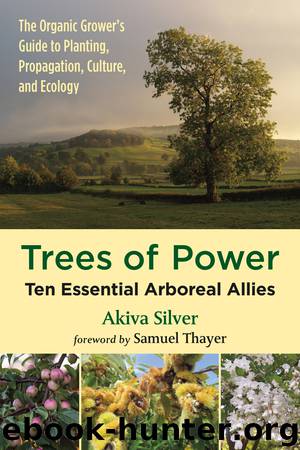Trees of Power by Akiva Silver

Author:Akiva Silver
Language: eng
Format: epub
Publisher: Chelsea Green Publishing
Chestnuts in bloom. They smell pretty weird, but they are beautiful and beneficial to many pollinators.
Cultivation
Cultivating chestnuts isn’t difficult if a few things are tended to. The trees do best with abundant sunlight, good drainage, and protection from voles and deer.
Pollination
Chestnuts are primarily wind-pollinated, monoecious trees (each tree produces male and female flowers). Though they are wind-pollinated, insects do play a large role in spreading pollen. They do not pollinate themselves, so two or more should be planted less than 50 feet apart. Occasional hybrid trees will have male-sterile pollen. This means they can receive female pollen and make nuts, but they can’t pollinate other trees. For this reason, I think it’s a good idea for people to plant at least three trees together.
Soil Preferences
Chestnut trees have a moderate-to-fast growth rate, similar to that of red maples. Of course, this depends on soil and tree health. They prefer good drainage and an acid pH, but this does not always have to be the case.
I have seen wild American chestnuts growing in low-lying swampy areas. At first glance, it seems that they can tolerate wet feet, but a closer look at the topography reveals something else. In older forests the ground is very uneven. As large trees topple over and are uprooted, a depression is created where the root mass once was. As the root ball breaks down, a mound is formed. This landscape feature is referred to as “pit and mound” or “pillows and cradles.” It is associated with almost all old-growth forests.
Pit-and-mound landscapes are essentially covered with vernal pools and raised beds (see “Uneven Ground” in chapter 2). Chestnuts, like almost all trees, prefer to grow on the mounds. If you have a wet field and want to grow chestnuts—or really any other fruit or nut tree—then make some mounds. Because without decent drainage around their root crown, chestnuts will languish.
Virtually all literature on chestnut cultivation speaks of the trees’ demands for acidic soil. However, I believe this depends on individual trees and species. I have on several occasions witnessed very healthy, mature chestnuts growing in alkaline soils. I believe that trees containing European and Japanese genetics are more likely to tolerate alkaline soil, but I have no scientific evidence to back this up. I also believe that high organic matter content in the soil will allow for greater flexibility of the tree to withstand differences in pH.
Spacing
Conventional wisdom is to plant trees on 40-foot centers. This is a big area for a small seedling to take up. Eventually, of course, the trees will be very large. In some old European orchards, only four trees fit per acre. There are several ways people have chosen to use the space that is not yet taken up by the young tree.
One method is to interplant chestnuts with shorter-lived species such as peaches, raspberries, and asparagus. By the time the chestnuts are spreading their shade, these other plants will be on the decline. With the same ideology, some farmers use alley cropping to grow vegetables, grain, or hay in between the rows until the chestnuts get big.
Download
This site does not store any files on its server. We only index and link to content provided by other sites. Please contact the content providers to delete copyright contents if any and email us, we'll remove relevant links or contents immediately.
| Fisheries & Aquaculture | Forests & Forestry |
The Lonely City by Olivia Laing(4120)
Animal Frequency by Melissa Alvarez(3755)
All Creatures Great and Small by James Herriot(3516)
Walking by Henry David Thoreau(3234)
Exit West by Mohsin Hamid(3183)
Origin Story: A Big History of Everything by David Christian(3139)
COSMOS by Carl Sagan(2950)
How to Read Water: Clues and Patterns from Puddles to the Sea (Natural Navigation) by Tristan Gooley(2855)
Hedgerow by John Wright(2776)
The Inner Life of Animals by Peter Wohlleben(2766)
Origin Story by David Christian(2683)
How to Read Nature by Tristan Gooley(2665)
Project Animal Farm: An Accidental Journey into the Secret World of Farming and the Truth About Our Food by Sonia Faruqi(2661)
How to Do Nothing by Jenny Odell(2645)
A Forest Journey by John Perlin(2587)
Water by Ian Miller(2584)
The Plant Messiah by Carlos Magdalena(2453)
A Wilder Time by William E. Glassley(2363)
Forests: A Very Short Introduction by Jaboury Ghazoul(2335)
